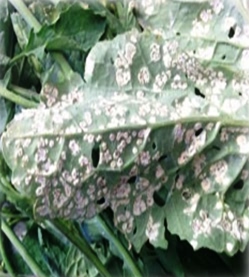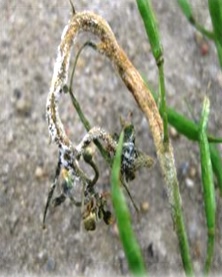सरसों की फसल के तीन प्रमुख रोग और उनका प्रबंधन
1. White rust disease of Mustard
It is also called "White Blisters of Crucifers". In severe conditions, it caused yield losses up to 55% in late sown crops. Other crucifers host-Radish, Tumip, Cabbage, Cauliflower, Taramira, Spinach & sweet potato (non-crucifers).
White creamy pustules & sporangia give white rusty appearance by exposing powdery mass of spores on the infected host surfaces, that's why it is called "white rust" (while it is not true rust. True rusts are caused by Uredinales i.e. Puccinia, Uromyces, Melampsora etc.). "Stag heads" are produced on floral parts due to systemic infection. Locally it is known as "Marodia Rog" or "Toontia Rog"
Symptoms: Symptoms are produced on all parts except roots. Symptoms appear as a result of two types of infection:
(i) In local infection: White creamy pustules of variable shape & size appear on the leaves, stem & inflorescence. Pustules merge to form large patches. The pustules, after the host epidermis ruptured, become powdery in appearance (Give white rusty appearance).
(ii) In systemic infection: Young stems & floral organs are infected & stimulate hypertrophy (increase in size of cells) & hyperplasia (increase in number of cells) resulting in abnormal enlargement of infected organs which give stage head appearance.



Upper surface Powdery white pustules Stag head deformation
About the Pathogen:- Albugo candida (also called Cystopus candidus).
The pathogen is an "Obligate parasite". Mycelium is coenocytic (without septa) branched & inter cellular with knob-like haustoria (i.e. food absorbing organ).Sporangiophores are short, club-shaped & thick at type base:
Sporangia are hyaline, spherical/globose & formed in "basipetal succession" in chains (i.e. sporangia are produced from the base, where youngest at the base while oldest at the tip of the sporangial chain). Oospores (sexual spore) are thick, warty, tuberculate or with roughened epispore.
Disease Cycle: The pathogen is soil-borne in nature.
Survival: The pathogen survives through "Oospores" lying in soil in infected plant debris. It also moves with diseased pieces along with the seed. It also survives on perennial weed hosts (e.g. horse radish) in mycelia stage.
Oospores can remain viable for 21 years under dry conditions. Oospores are formed in the hypertrophied tissues (leaves, stems, inflorescence, pods, roots) of infected host plants.
Primary infection: By primary inoculums (i.e. over seasoning part of pathogen) like oospores in soil or zoospores from weeds cause primary infection on lower leaves. Oospores germinate & produce zoospores that cause infection.
Secondary infection: Sporangia or zoospores produced on primary infected plants, serve as the source of secondary infection.
Pre-disposition:- Favorable environmental conditions like:
- Temperature below 150C (12-140C)
- High moisture conditions (RH 60-80%) favor the disease incidence & intensity.
- Other factors like application of irrigation at ood formation stage & late sowing (i.e. after 21st Oct.) favor the disease.
Management of White rust disease:
(a) Through Cultural Practices: As the pathogen soil- borne or survive on weeds.
- Use healthy & clean seeds or certified seeds.
- Destroy weeds in & around the field.
- Collect & destroy infected plant parts.
- Adopt field sanitation.
- Follow long crop rotation with non-host crops.
- Do early sowing (Grow the crop earlier than 20 Oct.)
(b) Through Chemical Control:
- Treat the seeds with "Apron SD-35" (metalaxyl) @ 6 g/kg seed (protect for 60 days) or "mancozeb" 92.5 g/kg seed).
- Spray the crop with Bordeaux mixture (0.8% = 4:4:50) or mancozeb (0.25%) or Ridomil MZ-72 (0.1%) at 10 days interval.
- Use recent fungicides like fosetyl-Al (Aliette). It has both apoplastic (through xylem) & symplastic (through phloem) movement. So, this is an Ambimobile fungicide.
(c) Through Resistant Varieties:
- Grow resistant genotypes like- Kranti (PR 15), RN 510, DIR-1522, PAB 2001, and PAB 2002 of Indian mustard.
(2) Alternaria Blight of Mustard
It is also called "Leaf spot" or "Black leaf spot" disease. Two species of Alternaria attack on mustard. It caused seed yield loss up to 35% in mustard.
Symptoms:
- Leaf spots caused by Alternaria brassicicola: Spots appear as dark colored & big in size (1cm dia.) with concentric rings (target effect).
- Leaf spots caused by Alternaria brassicae:- Spots appear as light colored & smaller in size with concentric rings (target effect).

About the Pathogen:
- Alternaria brassicicola (This species is more dangerous) And Alternaria brassicae.
Disease Cycle: The pathogen externally and internally seed & soil-borne (SSB) in nature.
- Survival: It survives through conidia & mycelium with seed & in infected plant debris in soil.
- Primary infection: Primary infection caused by conidia & mycelium on the lower leaves.
- Secondary Infection: Conidia produced on primary infected plants serve as the source of secondary inoculum during the same growing season Conidia carried out by wind on healthy plants, germinate & cause infection.
- Pre-disposing factors: Moist & foggy weather late sown crops are more attacked.
Management: "Use healthy seeds, in healthy soil"
(i) Through Cultural Practices:
- Maintain field sanitation.
- Follow crop rotation with non-host crops.
- Follow deep summer ploughing.
- Adopt early sowing (up to 21 Oct.)
- Treat the seeds with hot water at 50º C for 20 min.
(ii) Through Chemical Control:
Spray mencozeb or zineb or COC @ 2.5 g/ liter at water at an interval of 15 days from 45 DAS (days after sowing)
(iii) Through Resistant Varieties:
Grow resistant varieties like Pusa Kranti & Seeta var, of mustard. Grow multiple disease resistant varieties against Alternaria blight, white rust, Powdery Mildew & Downy Mildew of Indian mustard like: DIR-157 & DIR-1522.
(3) White Rot or Stem Rot of Mustard
Caused losses up to 50% (seed yield loss) in severe conditions. It is also called - stem blight or white blight. Earlier it was of minor importance but now become serious disease of crucifers.


Symptoms:
Sudden drooping of leaves followed by drying of plants are characteristic feature of the disease. White cottony, fungal growth is visible near collar/ crown portion of the stem with black sclerotial bodies on & inside the rotted stem/ portion.
When the infected stem is splitted, large cavities lined by fluffy mycelium & numerous black sclerotia of the fungus are seen, which are the main structures responsible for over seasoning & dissemination.
About the Pathogen:
Sclerotinia sclerotiorum : This fungus is a ubiquitous, omnivorous, soil-borne and destructive plant pathogen, causing disease in >400 plant spp. It belongs to class Ascomycetes & characterized by the formation of hard blackish sclerotia which on germination produce cup-shaped brown colored apothecia. Apothecia give rise asci & ascospores (sexual spores, 8 in number).
Disease Cycle: The pathogen is soil-borne & disease is monocyclic.
- Survival:- It survives through sclerotia in soil or admixture with seeds.
- Primary infection: Primary infection is caused by mycelium from myceliogenic germination of sclerotia and ascospores from apothecia.
- Secondary infection- There is no secondary infection as it is monocyclic disease.
- Pre-disposing factors:- High humidity (80-90%), Cool temperate (15-25 ºC). It is also favored by heavy soils, early sowing, mono cropping & 3 or more irrigations.
Management: "Use healthy seeds, in healthy soil"
(i) Through Cultural Practices:
- Burning of stubbles to destroy sclerotia.
- Deep burying of sclerotia by deep ploughing.
- Flooding of soil for 2-3 weeks.
- Follow long crop rotation with non-host crops (maize/wheat/ onion etc)
- Adopt late sowing (after third week of Oct.).
- Treat the seeds with hot water at 50ºC for 20 min.
- Remove lower leaves at 50-60 days sowing. (Removed leaves can be used as fodder).
- Maintain low plant population with spacing of 45 x 10 cm.
(ii) Through Chemical Control-
- Seed treatment with carbendazim (0.1%).
- Spray carbendazim @ 1 g/litre or Topsin M @ 2g/litre of water at 50-60 DAS (days after sowing).
- Drench the soil with carbendazim (0.1%)
(iii) Through Resistant Varieties:
- Grow resistant/ tolerant genotypes like Hyola - 401, Kiran, PAB-9511, Rh-492.
(iv) Through Bio Control:
- Treat the seeds with fungal bio-control agent (BCA) Trichoderma harzianum or Trichoderma viride culture @ 4-10 g/kg seed.
- Also apply Trichoderma or Coniothyrium minitans culture into soil @ 4-10 kg/ ha.
Authors:
Dr. A. L. Yadav|1* , Dr. Data ram kumhar2, Dr. A. K. Meena3
1,3 Assistant Professor, Department of Plant Pathology, College of Agriculture, Bikaner
2 Professor, Department of Plant Pathology, College of Agriculture, Bikaner
*Mail id-
